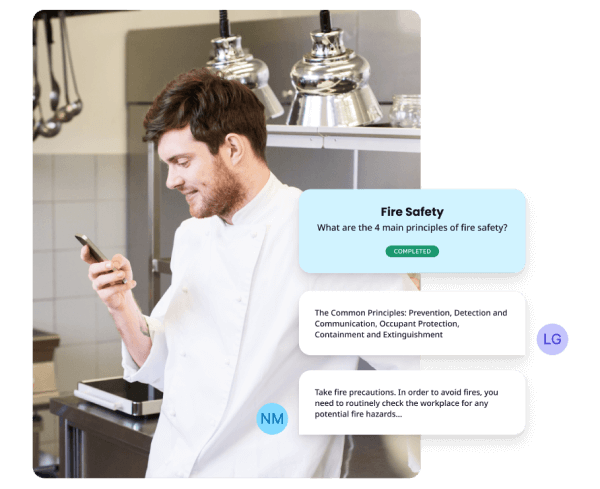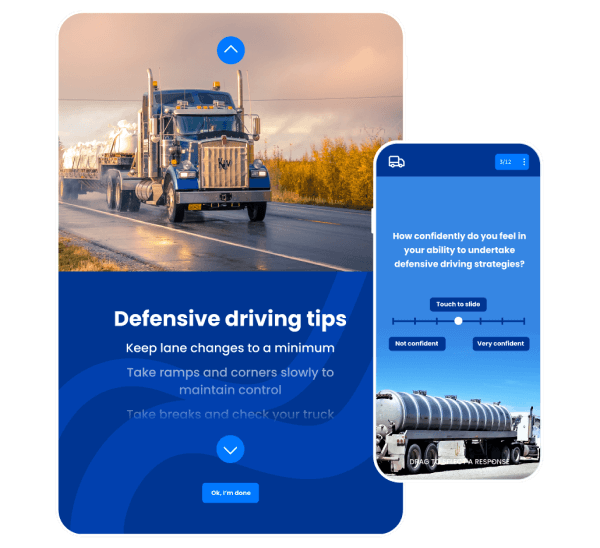10 Course Objectives Examples

As a training manager, it’s important to carefully think about what the objective of training should be and to consider your learners’ different levels of learning. After all, learning objectives examples can help you measure whether your training is successful or not.
If you don’t know where to start, we’ve listed some course objectives examples you can include in your training plan.
1. Better Learner Engagement
Learner engagement evaluates how much time and effort your trainees put into the learning process. This can be quantified using engagement indicators such as the amount of time spent on courses or the number of assessments taken. You can also merge this with other metrics discussed later in this list, such as course completion rates and training experience satisfaction. This helps them have a better understanding of how learners interact and participate with the learning content.Increase learner engagement and knowledge retention with memory training apps. These memory apps for adults contain features that can help you put important knowledge in learners' long-term memories so they perform better at work.

EdApp delivers analytics reporting features that offer you key data such as lesson completion as well as general data like log-in dates and hours. You can also apply gamification in EdApp to enrich your courses and promote employee engagement by transforming monotonous lessons into interesting mini-games and quizzes. This method can support you in convincing your learners to take their courses more frequently.
Gain better learner engagement by signing up for EdApp today.
2. Increased Assessment Pass Rates and Scores
Assessment pass rates indicate how many of your trainees pass or fail a course. A high failure rate could indicate that something's missing in your training program. If your pass rates are unusually low, you can investigate what caused it. Were the questions overly detailed? Do learners have enough time to study everything that's expected of them?

You can apply EdApp's Brain Boost function to encourage spaced repetition as a technique to boost assessment performance. This feature automatically recreates lessons based on previously studied information and focuses on topics that they may be having a hard time with. This helps your learners embed crucial concepts in their long-term memory as they absorb the topic again.
3. Improved Course Completion Rate
Course completion rates indicate how much of the course your trainees completed. You can enroll a big number of employees in a course, but if the completion rate stays low, you may need to redesign your training programs or rethink them from scratch altogether.

To increase your training metrics and make your training more interesting, you can apply mobile learning tactics or seek microlearning solutions like EdApp. Microlearning is all about cutting down enormous volumes of learning data into smaller, more consumable bits of information. Your learners are more likely to complete their courses if you divide classes into smaller chunks.
4. Greater Training Experience Satisfaction
Training experience satisfaction is a common course objective example that's typically evaluated in a post-training survey. It's used to determine how satisfied learners are with their course. You can ask learners to score the training on a scale, collect feedback through questions, or offer some room for them to submit comments on their training experience.

This allows you to determine whether the course was effective in the view of the learners. It can also give you insight as to what aspects you need to improve on and what areas worked for your trainees.
5. Reduced Training Cost per Employee
Training cost per employee is a simple statistic that divides overall training costs by the number of employees. This formula can be used for a single training program or for the aggregate of all training completed over a given time period. You can determine if you're splurging on training or if the training cost has been justified. You can also use this indicator to plan your subsequent training expenditures and new course objectives examples, making sure that resources are used effectively and efficiently.

6. Better Training Return on Investment
The performance or profitability of your training is measured by the return on investment (ROI). This statistic is typically associated with increased revenue and business effects. While you may not be required to use this statistic as a course objectives example, it can still help you pinpoint your most effective training programs.

Let's say you wanted to enhance your call-based sales and sent your staff to a specific training program, such as telephone skills training. Following completion, you should track increased customer satisfaction, sales performance, and net profits to determine whether the training was worthwhile. If it were, this could be considered a good return on investment.
7. Decreased Learner Drop Off Rate
The learner drop-off rate indicates how many of your trainees began a course but didn't finish it and instead chose to drop out. Ideally, you should track where the learners have fallen out of the course. This information can help you determine whether or not there are any potential issues with a certain course or training area. It also aids in determining the quality of your training content, and if you're performing online training, it may even detect device compatibility difficulties.

8. Higher Employee Performance Post-Training
Employee performance post-training is another course objectives example on this list. This training metric examines the evolution of employee performance in relation to training across time. You can only quantify it with your more impactful training programs, much like the training ROI. Depending on the difficulty of the skill being learned, the influence of the training may be visible immediately or over a period of time.

This can be tracked with other staff performance measures such as sales, active leads, and mistakes. This can help you determine which training methods are the most successful at teaching a new skill in a given length of time.
9. Boosted Employee Morale

Another course objectives example to consider is a boost in employee morale. When you deliver the right training, your learners will be more motivated to perform better and faster. Anyone in management or human resources must understand that when employee morale is good, work no longer seems hard for the employees. Employee motivation is a significant aspect that influences employees' mental and emotional states; it will always impact their work habits and performance.
10. Smooth Onboarding Experience
When you’re making a course dedicated to new hires, this course objective example should be at the top of your mind. After all, onboarding is where they’ll make their first impressions of your organization. Having a smooth onboarding experience will allow new members to feel more welcome in your organization and understand how everything works and what’s expected of them.

If you don’t know where to start your onboarding courses, EdApp can help build a customized one for your teams. With EdApp’s Course Creation services, you’ll be able to access their expert instructional designers and have them build quality onboarding training for you. All you have to do is get in touch with them and they’ll get everything you want done in a flash.
EdApp is a mobile learning management system designed for today’s digital habits, delivering more engaging and effective micro-learning directly to learners anytime and anywhere.
Sign up for this course maker tool today.
Author
Stephanie Escuadro
Stephanie is an eLearning content writer for EdApp, a microlearning solution designed for today's digital habits. She creates content about cutting-edge learning technologies and resources to help companies deliver great training experiences. When not absorbed in writing, she spends her time taking care of her dog and binge-watching.
